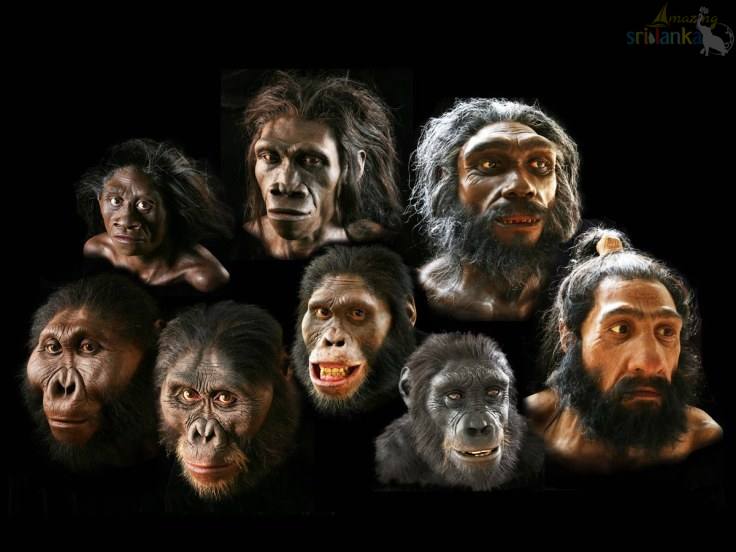Our Lost Cousins : Extinct Human Species

Our Lost Cousins
Extinct Human Species
By Ama H. Vanniarachchy
Our species is known as the Homo sapiens. We are the only surviving Homo species in today’s world. However, we were not the only human species that walked on earth. A very long time ago we shared the earth with more species of humans. This means human diversity was high at some point in history.
The history of the earth is calculated to be 4.5 billion years. Modern humans known as the Homo sapiens evolved between 400,000 and 250,000 years ago as they evolved from the family hominid (great apes). Scientists have unearthed evidence of many human species that evolved from the great apes, except for Homo sapiens.
But the question is how and why all of them went extinct? Was it due to a natural phenomenon that whipped off all of them? Or, as many scientists now believe, was it us who are responsible for the extinction of these many human species? It is evident that only after we appeared, these many human species went extinct.
Today we will explore a number of extinct human species with whom we shared the earth.
Homo habilis
It is believed that H.habilis, known as the handy-man, lived between 2.4 and 1.4 million years ago. Homo habilis was discovered in 1960 by a research team at Olduvai Gorge, Tanzania. Researchers placed the H.habilis somewhere in between the australopiths and humans. They had ape-like features such as long arms and a moderately prognathic face which was smaller and had smaller teeth. Research revealed that they had larger brain cases in the range of 550cm to 687cm. This species is believed to be the first true human species who actually behaved in a human-like way.
Homo erectus
Homo erectus or the upright man, lived during the Pleistocene period from about 1.9 million years to 143,000 years ago. The first H.Erectus fossil was discovered in Java in the early 1890s by Eugène Dubois. Scientists believe that H.erectus looked and behaved in a human-like way. Their long legs helped them to explore out of Africa and spread across Eurasia. Their elongated legs and short arms helped them climb trees easily and run faster than modern-day human beings. They are known to be the earliest humans to learn about fire, and to cook food.
Homo neanderthalensis
Known as the Neanderthals, they are the most famous extinct human species. Probably because they are the first ancient human species to be discovered, in 1829. Neanderthals are believed to have lived in Eurasia roughly 200,000 years ago and went extinct about 400,000 years ago. This human species is also sometimes known as the cousin of our species as both are believed to be sharing the same parent species, the Homo heidelbergensis. They made fine stone and bone tools, controlled fire, and produced simple art such as symbolic ornaments they had worn. The tools they used for hunting had a variation, which suggests their development of cognitive behavior. Their burials support this as they have buried the dead with offerings of flowers. Neanderthals were stronger and larger than Homo sapiens.
Homo heidelbergensis
This species lived between 700,000 and 200,000 years ago in Africa and was discovered in 1907 by a worker in Germany. He handed it over to Professor Otto Schoetensack from the University of Heidelberg who later identified and named the fossil. Studies reveal that they had a large brain case with a flatter face than modern humans. This species is known for two special abilities; one is to adapt to colder climates and build shelters for them. Secondly, they are known to be the first human species that hunted large animals.
The Denisovans
Recently discovered (in 2010) Denisovans are not yet formally recognized as a species or a subspecies. Once they are, they will be known as Homo denisova. They are believed to have lived about 200,000 years ago and 50,000 years ago in eastern Asia. Still we do not know much about this species as they were not actually ‘unearthed’; in fact, they were discovered in a genetics lab. In 2010, researchers analysed DNA samples pulled from fragments of 50,000-year-old human teeth and bone found in a cave in Siberia.This population is now known as the Denisovans. Some studies report that a few more fossils have been found, but things are not official yet.
Homo floresiensis
Discovered in 2003, Homo floresiensis is also known as the hobbit. They lived on the Indonesian island of Flores, some 100,000 to 50,000 years ago. They are believed to be short, had unusually long feet, and a tiny brain. They also had the ability to control fire and cook food. They produced stone tools. Some researchers say that this species is a strange variant of H.erectus, as they were isolated in this island and developed into a short, small brained species; while some argue that there is a direct link between them and H.erectus.
Homo naledi
Another recently (2013) discovered human species, Homo naledi, is also called the star man. They lived in South Africa between 300,000 and 200,000 years ago. As this species is still new and research is not complete, these dates are not yet officially accepted. They may vary depending on future studies. They looked partly human and partly ape with a brain little larger than that of a chimpanzee. Their burial rituals suggested that they behaved like humans as they disposed of the dead in rock chambers. Scientists suggest that they lived at the same time as H.habilis and went extinct more than a million years ago while some say that they existed until a few hundred thousand years ago.
Homo Rudolfensis
Homo Rudolfensis is believed to have lived around 1.9 million to 1.8 million years ago. Research reveals that they had heavy muscles and smoothly rounded occipital bones similar to that of H.erectus.
This is not a complete list of extinct human species. There are more. The number will change in future and there will be more additions. The story of human evolution keeps changing.
Uncategorized
